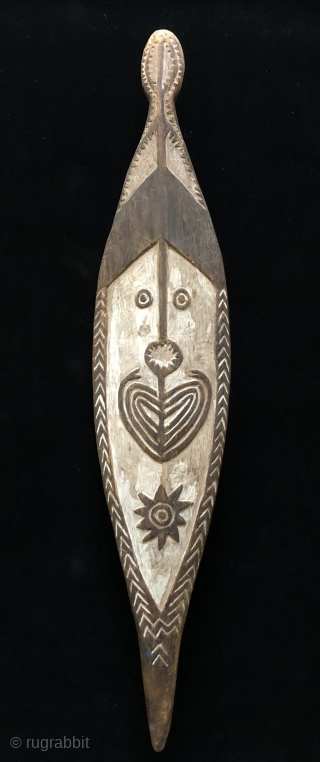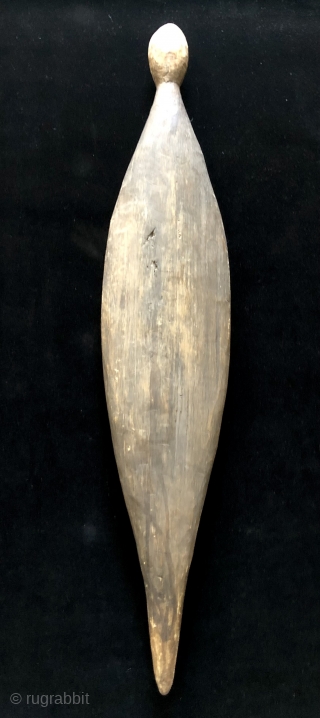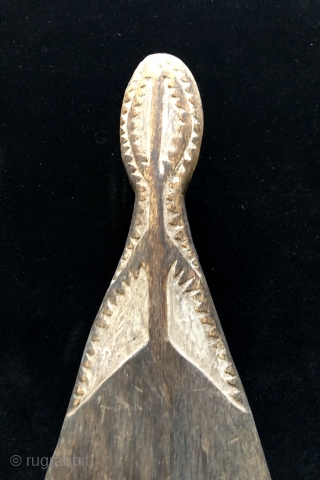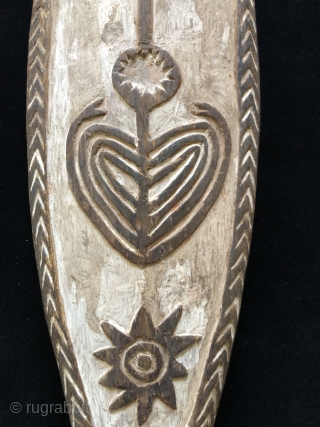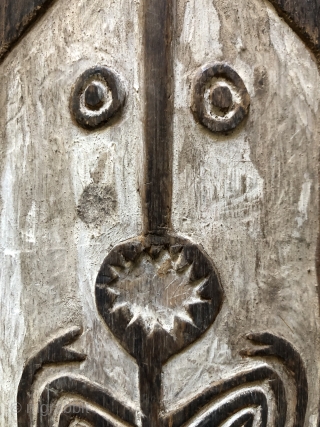Back
Papua New Guinea Spirit board (gope). Size: 26 x 5.5 x 2 inches. Wood plank carved in low relief. Applied white lime with traces of red ochre remaining.
*Description that follows is from the Metropolitan Museum of New York's website.
The Papuan Gulf region encompasses the arts and cultures
of the Gulf of Papua on the southeast coast of New Guinea.
In the past, the primary focus of religious and artistic life
in the region was on powerful spirits (imunu). Each imunu
typically was associated with a specific location in the
landscape, rivers, or sea, and was linked to the specific
clan within whose territory it dwelt.
Papuan Gulf wood sculpture was primarily two-dimensional,
consisting of board-like carvings and figures with designs in
low relief. The signature art form was the spirit board, an
oblong plank-like object known variously as a gope, koi, or
hohao, depending on the region in which it was made. Each
served as a dwelling place for an individual imunu, whose
image appears on it. Villages formerly had large communal
men’s houses divided into cubicles, each allotted to a
particular clan or subclan. Every cubicle contained a clan
shrine, which housed the spirit boards, figures, human and
animal skulls, and other sacred objects associated with the
clan’s various imunu.
price:
INQUIRE
- Home
- Antique Rugs by Region
- Category
- Profiles
- Post Items Free
- Albums
- Benaki Museum of Islamic Art
- Budapest: Ottoman Carpets
- Gulbenkian Museum
- Islamic Carpets. Brooklyn
- Islamic Textiles. Brooklyn
- Konya Museum: Rugs
- MKG, Hamburg
- MMA: Caucasian Carpets
- MMA: Mamluk Carpets
- MMA: Mughal Indian Carpets
- MMA: Ottoman Carpets
- MMA: Safavid Persian Carpets
- MMA: Turkmen Rugs
- McCoy Jones Kilims
- Ottoman textiles. Met
- Philadelphia Museum
- Rugs and Carpets: Berlin
- Seljuqs at the Met
- TIEM, Istanbul: Carpets
- V&A: Classical Carpets
- Vakiflar Carpets: Istanbul
- Baluch Rugs: Indianapolis
- Gallery Exhibitions
- Jaf an Exhibition
- Alberto Levi Gallery
- Andean Textile
- Christie's London: 2016
- Francesca Galloway
- HALI at 40
- ICOC Washington, DC 2018
- Jajims of the Shahsavan
- London Islamic Week April, 2018
- Mongolian Felts
- Navajo Rugs: JB Moore
- Persian Piled Weavings
- SF Tribal & Textile Art Show 2020
- SF Tribal 2019
- Sotheby's: C. Alexander
- Turkish Prayer Rugs
- Turkmen Main Carpets ICOC 2007










